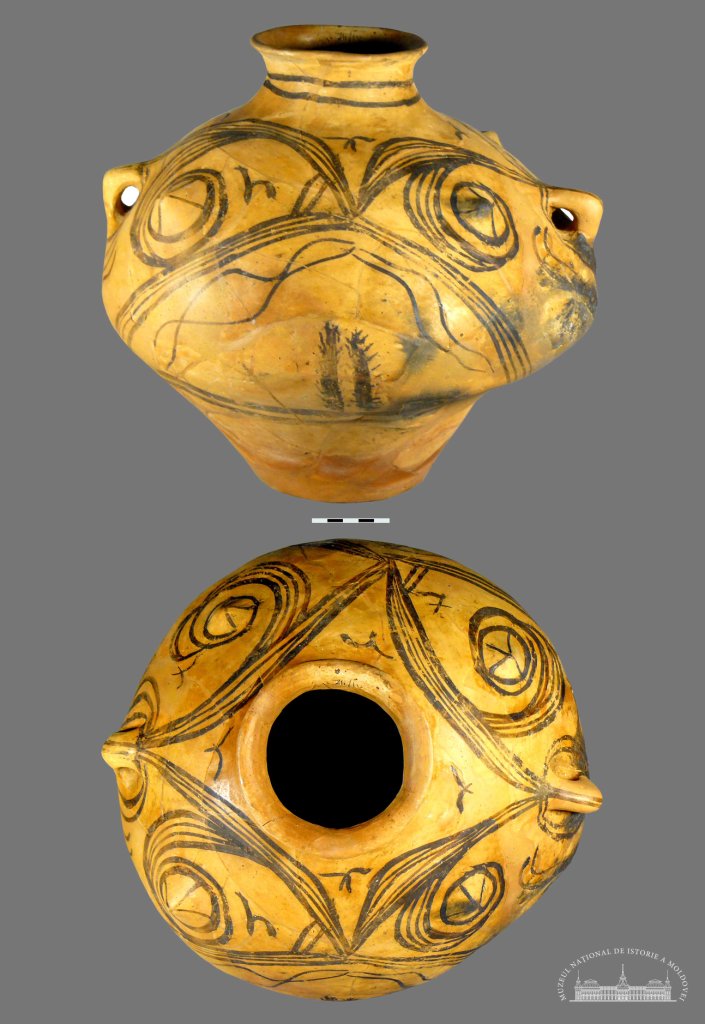  #Exhibit of the Month #Exhibit of the Month
September 2021
Painted amphora from Şuri
 This unique amphora was found in 1984 during the excavations of the Şuri I settlement of the Cucuteni-Trypillia culture (5th-4th thousand BC), which existed in the Eneolithic era, in the mid-1st half of the 4th millennium BC, near the village of Şuri, Drochia District of the Republic of Moldova.
In the classifications of Cucuteni-Trypillian painted pottery, it belongs to a separate type distinguished by archaeologists, known in the special literature under various names: facial urns, amphorae with an ornament of the "owl face" type, amphorae with facial ornament, facial amphorae. These names were given to the amphorae due to their peculiar ornament and their truncated-conical or rounded body that resembles the head of an owl (large circles on the sides of the handles are the eyes of a bird, and the handles are beaks), as well as due to attempts to hypothetically interpret the vessels as images of some two-faced or four-faced anthropomorphic, zoomorphic or ornithomorphic mythological creatures of the Cucuteni-Trypillian pantheon. For the first time, amphorae with facial ornament appear in pottery assemblages of the Cucuteni-Trypillia community at the beginning of the 4th millennium BC, during the period of its highest flourishing, and are present later, as a separate type of tableware, in each of the dwellings of the settlements of this culture for about 700 subsequent years, until its collapse and disappearance from the historical arena in the last quarter of the 4th millennium BC. The origin of the facial amphorae goes back to the anthropomorphic two-faced vessels with a rounded or spheroconical body, equipped with 2 or 4 handles, depicting two female figures standing with their backs to each other, which were used by the Cucuteni-Trypillians for centuries and were widely used in religious practices, representing, as is commonly believed, the main female deity of the Cucuteni-Trypillian pantheon - the Great Mother Goddess in her two different incarnations, who was also considered as the Deity of the Universe. The study of vessels of this type indicates that, being a reflection of the cult of the Great Goddess and probably embodying cosmogonic ideas about the creation of the World from the elements and body parts of the Primordial Being (probably depicting this creature itself, possibly mixomorphic and like Aditi - the Divine Bull-Cow - androgynous), with their shape and ornament, the facial amphorae recreate the prevailing ideas of the Cucuteni-Trypillians about the structure of the Universe. This is evidenced by the stylized features of anthropo- and zoomorphism, three-tier or two-tier division of the ornament vertically and four-tier division horizontally, the image of such cosmic universals as the Center and corners of the World, the Cosmic Mountain (Earth) and the Sky, the Tree of Life, the Sun, the Moon in various phases, etc. Often, images of animals, birds or their symbols are included in the ornamental system of the amphorae. There are also facial amphorae with two or four images of female deities with an indication of their particular characteristic functions. As with their prototypes, the anthropomorphic two-faced vessels, the most important ornamental zone in the facial amphorae is the space between the handles. It is here that the ornament reflects one of the most significant themes of the Cucuteni-Trypillian religion, the theme of the connection between the Earth and Heaven.
|





 The side panels are elegantly decorated with refined cast-iron elements in the Art Nouveau style, displaying the brand name - "Ideal." The Polyglott model, featuring a bilingual keyboard patented in the United Kingdom by Max Klaczko from Riga, Latvia, was produced between 1902 and 1913, marking the first typewriter capable of writing in two languages. The "Ideal Polyglott" typewriter was actively sold in the Russian Empire and gained significant popularity in Poland, Bulgaria, and Serbia.
The side panels are elegantly decorated with refined cast-iron elements in the Art Nouveau style, displaying the brand name - "Ideal." The Polyglott model, featuring a bilingual keyboard patented in the United Kingdom by Max Klaczko from Riga, Latvia, was produced between 1902 and 1913, marking the first typewriter capable of writing in two languages. The "Ideal Polyglott" typewriter was actively sold in the Russian Empire and gained significant popularity in Poland, Bulgaria, and Serbia.













































